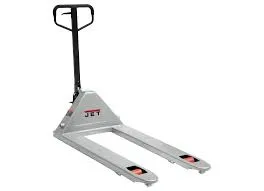


Industrial Fall Protection Equipment Ensuring Safety at Heights
In the realm of industrial safety, fall protection equipment stands as a critical component in safeguarding workers from the hazards associated with working at elevated heights. With the construction, manufacturing, and maintenance industries frequently involving elevated tasks, ensuring that employees are protected from falls is both a legal obligation and a moral imperative. This article delves into the various types of fall protection equipment, their applications, and the importance of adhering to safety standards.
Understanding Fall Hazards
Before discussing the equipment, it’s essential to understand the nature of fall hazards in industrial settings. Workers may encounter various risks when performing tasks on ladders, scaffolding, rooftops, or elevated platforms. According to the Occupational Safety and Health Administration (OSHA), falls are one of the leading causes of workplace injuries and fatalities. These incidents can result in severe injuries, leading to prolonged recovery times, medical expenses, and lost wages for workers, as well as legal ramifications for employers. Thus, preventing falls through proper equipment and training is paramount.
Types of Fall Protection Equipment
1. Personal Fall Arrest Systems (PFAS) These systems are designed to safely stop a person from falling. A typical PFAS comprises a full-body harness, a lanyard or lifeline, and an anchor point. The harness distributes the force of a fall over the body, mitigating potential injuries.
2. Guardrails These are fixed barriers installed along edges of elevated work surfaces. Guardrails serve as a physical barrier that prevents workers from falling off edges. They are highly effective in environments where temporary work is required.
3. Safety Nets Installed beneath elevated work areas, safety nets catch workers if they fall. They are particularly useful for construction sites where multiple workers are operating at different levels and can cover wide areas.

4. Ladders and Scaffolds While not traditional fall protection equipment, ensuring that ladders and scaffolding are constructed and used correctly is crucial in preventing falls. They should be inspected regularly and comply with safety standards.
5. Rescue Equipment In the event of a fall, having rescue equipment on hand is crucial. This may include rescue harnesses, stretchers, and systems for safely recovering someone who has fallen and is hanging in the harness.
Regulations and Compliance
Various regulations govern the use of fall protection equipment to ensure safety in the workplace. OSHA mandates that employers provide appropriate fall protection for workers exposed to fall hazards. Regular training is also required so that employees understand how to properly use fall protection systems. Adhering to these regulations not only ensures safety but also protects employers from potential liabilities.
Training and Maintenance
While having fall protection equipment is vital, it is equally important to invest in thorough training programs. Workers must be educated on the correct use and limitations of equipment. Regular maintenance checks should be conducted to ensure that all equipment remains functional and compliant with safety standards. This proactive approach not only enhances worker safety but also prolongs the lifespan of the equipment.
Conclusion
In conclusion, industrial fall protection equipment plays a pivotal role in minimizing the risk of falls in various work environments. By utilizing personal fall arrest systems, guardrails, safety nets, and other protective measures, industries can significantly reduce the incidence of fall-related injuries and fatalities. Complying with regulations, providing training, and maintaining equipment are essential steps in fostering a culture of safety. Ultimately, prioritizing fall protection not only safeguards workers but also enhances overall productivity and morale within the workforce. Investing in safety is investing in the future of both the individual and the organization.



